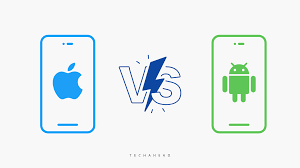iOS vs Android Development: Which Platform is Right for You?

Strong 8k brings an ultra-HD IPTV experience to your living room and your pocket.
Choosing between iOS and Android development is a critical decision for any mobile app developer or business. Both platforms dominate the global smartphone market, but they have distinct differences that can impact your development process, audience reach, and potential revenue. In this article, we'll compare iOS and Android development across several key factors.
- Market Share & Audience
Android holds about 70% of the global market share, offering access to a broader, more diverse audience across different price points. It's particularly strong in emerging markets.
iOS, while having a smaller share (about 28% globally), dominates in wealthy markets like the USA, UK, and Japan. iOS users tend to spend more on apps and in-app purchases.
- Development Languages
iOS primarily uses Swift (Apple's modern programming language) or the older Objective-C. Swift is known for its clean syntax and safety features.
Android apps are typically built with Kotlin (Google's preferred language) or Java. Kotlin offers concise code and interoperability with Java.
- Development Environment
iOS developers use Xcode, available only on macOS. This means you'll need a Mac to develop iOS apps.
Android developers use Android Studio, which runs on Windows, macOS, and Linux, offering more flexibility in hardware choices.
- Fragmentation Challenges
Android faces significant fragmentation with thousands of device models, screen sizes, and OS versions. This can make testing and optimization more complex.
iOS has limited device models and faster OS adoption rates, making development and testing more straightforward.
- App Store vs Google Play
Apple's App Store has stricter review guidelines but typically generates higher revenue per user. The approval process can take several days.
Google Play has more lenient policies and faster review times (often just a few hours), but discoverability can be challenging due to the sheer number of apps.
- Development Costs
iOS development may require a higher initial investment (Mac hardware, developer account), but often has lower ongoing maintenance costs due to less fragmentation.
Android development can have higher long-term costs due to the need for extensive testing across devices and resolutions.
- Development Languages & Tools
iOS primarily uses Swift, Apple's modern, fast, and safe programming language, though some legacy apps still rely on Objective-C. Developers must use Xcode, which is only available on macOS, adding to the initial setup cost.
Android apps are typically built with Kotlin (Google’s preferred language) or Java. The development environment, Android Studio, runs on Windows, macOS, and Linux, providing more flexibility.
- Monetization & Revenue
The App Store generates higher revenue per user, making it ideal for paid apps and premium subscriptions. However, Apple takes a 15-30% commission on sales.
Google Play has a larger user base but lower spending per user. Monetization often relies on ads and freemium models. The approval process is quicker, but discoverability is challenging due to competition.
Which Should You Choose?
Consider iOS if:
- Your target audience is in North America or other affluent markets
- You prioritize higher revenue per user
- You want a more standardized development environment
Consider Android if:
- You're targeting global markets, especially developing countries
- Your app requires deep hardware integration or customization
- You want to reach the largest possible user base
Many successful developers choose to build for both platforms, either through cross-platform frameworks (like Flutter or React Native) or by maintaining separate native codebases.
Ultimately, your choice should align with your target audience, business goals, and technical requirements. Both platforms offer robust ecosystems and opportunities for successful app development.
Note: IndiBlogHub features both user-submitted and editorial content. We do not verify third-party contributions. Read our Disclaimer and Privacy Policyfor details.



